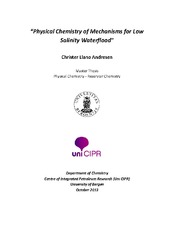Physical Chemistry of Mechanisms for Low Salinity Waterflood
Master thesis
Permanent lenke
https://hdl.handle.net/1956/7688Utgivelsesdato
2013-10-23Metadata
Vis full innførselSamlinger
- Department of Chemistry [433]
Sammendrag
Low salinity injection as an alternative EOR method to enhance the production of reserves has for decades been investigated. Increasing evidence that reduction in brine salinity can cause a significant impact on the oil recovery has led to a greater worldwide interest among scientists and industry. Despite all the attention, the prevailing mechanism responsible for the favorable contribution is up to date an unsettled issue due to the complex in-situ crude oil/brine/rock interactions. The physical chemistry of mechanisms occurring between crude oil and brine has been investigated in this thesis. For a comprehensive study, adhesion maps were performed to examine the wettability behavior in different three phase systems. The two different crude oils used in this thesis came from the Heidrum field, located in the North Sea. Crude oil/brine interactions were investigated through electrophoretic and interfacial tension studies. These interactions were examined as a function of pH and brine composition. The composition of brine was modified with respect to ionic strength, ion type and ion-valence. Through the electrophoretic studies it was proven that brine composition and pH impacted the charge between crude oil/brine significantly. Higher pH caused more acidic constituents in the oil phase to ionize and thus increased the net negative charge at the oil/brine interfaces. Reduced salinity, especially from multivalent to monovalent cations, lowered the screening potential and caused a higher negative charge at the oil/brine interfaces. Interfacial tension between crude oil/brine was only partially affected by reduction in brine salinity, but pH at high alkaline environment resulted in dramatic reduction in the interfacial tension due to ionized acidic species granting the oil phase a hydrophilic character. The adhesion map results revealed that wettability alteration from water-wet towards oil-wet was not affected by brine salinity, but was rather highly dependent on pH where adhesion was mainly observed at intermediate acidic conditions.
